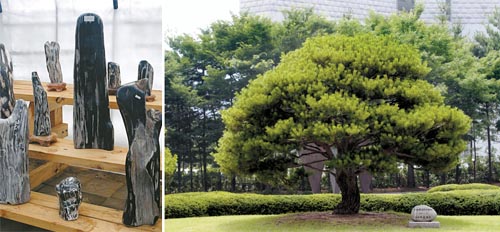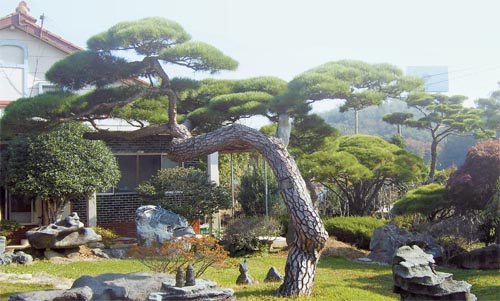Landscaping trend leaves no stone unturned

Natural stones from Ansan, Gyeonggi, left, and a pine tree planted by former President Kim Young-sam decorate the Supreme Prosecutors’ Office in Seocho District, southern Seoul. [JoongAng Sunday]
Landscaping was once the domain of chic golf courses and galleries, but as Koreans become more interested in greening urban environments, especially residential areas, home and building owners are increasingly investing in expensive outdoor decor.
Accordingly, the money spent on landscaping has increased exponentially, in some cases elevating property values by 30 to 40 percent.
And people are going to increasingly extravagant extremes to obtain old and ever more exotic looking trees and rocks.
When Kim, a head of a corporation who asked to remain anonymous, decided to landscape his property, a pine tree with odd, curling branches caught his eye. So he had it extracted from the mountain where he saw it and planted in his yard. He had another pine tree with a beautiful fan shape airlifted from South Chungcheong and installed as well. Each tree cost 20 million won ($19,000).
In return, Kim got a warranty from his landscape architect that tells where the trees are from and how old they are. Kim said that he wanted the warranty in case he decides to sell the trees later.
“These trees are precious and special looking to anyone who sees them,” Kim said. “If I happen to sell them later, I know they will go for a much higher price than what I paid, so that’s why I wanted to get the warranty.”
One professor, who also wishes to remain anonymous, found his muse at the Wang-sung Arboretum in Seoul.
On a visit to the arboretum, located in Gangdong District, the professor asked an official if he could buy one of the stones he saw there. The professor said he was impressed by the shape, which he said was unique because it looked like a sculpture of the human body.
In response, the arboretum official said that although the stone is rare, he ended up selling it to the professor because he knows the professor is a nature-lover and the professor had previously purchased a pine tree from the arboretum.
The professor bought the stone for 5 million won.

A garden at Daeyoung Farm in Sacheon, South Gyeongsang, has installed a variety of rocks and pine trees.
Like Kim and the professor, many people have found trees or rocks that capture their imaginations while hiking up a mountain.
But taking a natural treasure home is difficult because it is not possible to dig up or transport an item found in nature without express permission of the Korea Forest Service.
An Byung-ki, the deputy director of the KFS, talked about the KFS’ restrictions.
“Removing plants from a mountain is not permitted because the Forest Service does not approve of digging,” An said. “Permission for digging is rarely given except when there is construction of roads and dams that requires the trees and rocks to be taken out.”
But those who do gain permission to remove these items have the potential to earn vast amounts of money - not only because of the difficulty of gaining permission to extract trees and rocks, but also because the most desirable items are often several years old.
“It takes between 10 and 100 years for a tree to gain recognition as a valuable and picturesque object for landscaping,” Yun Young-gwan, the chief of a construction company, said. “Also, it is extremely difficult to find a handsome rock in nature.”
Pine trees that are 50 years old and taller than 10 meters can fetch prices of between 10 million won and 100 million won. Many pine trees, a particular favorite among Koreans, end up in front of corporations or apartment complexes.
“Pine trees lend a natural glow to gardens throughout all four seasons,” Ryu Han-geon, the chief of landscaping committee at GS Construction Company, said. “So, they are the most popular tree among Korean people.”
In addition to the cost of the tree itself, a meticulous landscaping plan costs hundreds of millions of won. But for those involved in the trend, the resulting beauty makes up for the expense.
“One of the most common landscaping patterns places a pine tree in the center of the property, with royal azaleas and fruit trees around the circumference.”
Aside from the trees and rocks found in nature, trees that were planted by a public figure also receive high appraisals.
The “YS Pine Tree” in front of the Supreme Prosecutors’ Office, southern Seoul, planted by former President Kim Young-sam was valued at 30 million won when he planted it in 1995. Its value has since quintupled to 150 million won.
Trees with strong immune systems are often the most expensive. A tree that survives and continues to grow after it has been transplanted will often see its immune system get stronger. Trees that have survived transplanting can sell for up to double their original price.
“When a tree is being transplanted, there is a regrowth of the plant through the main root system, stimulating new growth of rootlets,” Lee Sang-seok, a professor at the University of Seoul, said. “This process increases the tree’s value.”
Rocks found in nature and used for landscaping can be similarly expensive.
There are many kinds of rocks used in landscaping, including rocks collected from nature and rocks that have been broken off from boulders or cliffs and reshaped.
Stone steps and walls are usually made from sculpted rocks, which can cost from 20,000 to 40,000 won each.
Decorative rocks are usually transplanted to urban gardens as is, though they are still quite expensive and hard to procure. Rocks of this kind can usually be purchased in North Chungcheong and Gangwon provinces.
The large stone markers found in front of public offices and corporations can cost from ten to hundreds of millions of won. The one that is placed behind the National Assembly in 2008 was famous for its size and cost. The seven-meter-high marker weighed 68 tons and cost 210 million won, and that didn’t even include the installation price.
But although landscaping seems like it would be out of reach for the average person, there are ways to do it for less.
“It is not necessary to decorate your garden with fancy trees and rocks,” Lee, the University of Seoul professor, said. “A beautiful garden can be made without expensive trees and a person can enjoy growing their own plants, bringing harmony to the home.”
And some trees are fairly affordable.
According to the Public Procurement Service, a young pine tree that is 2 meters high and 6 centimeters wide is valued at around 100,000 won. A medium-sized pine tree with a height of 5 meters and a width of 20 centimeters is valued at just under 750,000 won. The price can vary according to the size of the tree, its appearance and the existence of fruit. And surprisingly, blueberry trees are not expensive and can be purchased for as little as 100,000 won.
By Lee Tae-kyung [estyle@joongang.co.kr]










with the Korea JoongAng Daily
To write comments, please log in to one of the accounts.
Standards Board Policy (0/250자)